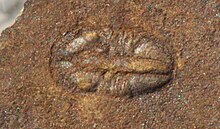Pagetia
| Pagetia Temporal range:
| |
|---|---|

| |
| A heavily eroded specimen of Pagetia taijiangensis, 6 mm, from Kaili, Guizhou, China | |
| Scientific classification | |
| Kingdom: | |
| Phylum: | |
| Class: | |
| Order: | |
| Suborder: | |
| Family: | |
| Genus: | Pagetia |
| species | |
| |
| Synonyms | |
|
Eopagetia, Mesopagetia | |
Pagetia is a genus of small trilobite, assigned to the Eodiscinid family Pagetiidae and which had global distribution during the Middle Cambrian. The genus contains 55 currently recognized species, each with limited spatial and temporal ranges.
Type species
[edit]Pagetia bootes Walcott, 1916, from the middle Cambrian (late Wuliuan or base Drumian) Burgess Shale fossil Lagerstätte. The species occurs with Ptychagnostus praecurrens and derives originally from the "greater phyllopod bed" of Walcott quarry on "Fossil Ridge" between Wapta Mountain and Mount Field, approximately 5 kilometres north of Field, British Columbia in the Canadian Rocky Mountains. The presence of Pt. praecurrens, indicates correlation with the Swedish praecurrens Biozone (Baltoparadoxides pinus Biosubzone, A2 of Westergård 1946, pp. 98–100) in the upper part of the oelandicus Superzone. [5]
Taxonomy
[edit]Order: Agnostida Salter, 1864. [6] Suborder: Eodiscina Kobayashi, 1939. [7] Family: PAGETIIDAE Kobayashi 1935. Genus: Pagetia Walcott, 1916. (op. cit.).
Species previously assigned to Pagetia
[edit]- P. attleborensis = Hebediscus attleborensis
- P. jinnanensis = Sinopagetia jinnanensis
- P. maladensis = Macannaia maladensis
- P. medicinalis (plant, Rutaceae) = Bosistoa medicinalis
- P. monostylis (plant, Rutaceae) = Bosistoa medicinalis
Description
[edit]A genus of the Family Pagetiidae and mainly differentiated from members of the Eodiscidae in having eyes and proparian facial sutures. In the type species, Pagetia bootes Walcott, 1916, there is a well-defined preglabellar median furrow separating the genae. Glabella is well defined, tapers slightly forward and has a well developed spine extending rearwards from the glabella. Anterior border is crenulated, which is common amongst both Eodiscidae and Pagetiidae. No genal spines. Thorax of two segments; pleurae fulcrate with anterior pleural tips pointing backwards and those of the posterior segment directed forwards to enable enrolment. Pygidial axis is well defined, reaching or overhanging the posterior border, usually with five rings and commonly extending backwards into a prominent postaxial spine.[8]
The hypostome is a convex subquadrate plate, positioned directly under frontal part of the glabella. It is comparable to the hypostoma of other trilobites and provides an argument that Agnostida can be regarded as specialized, simplified trilobites.[9]
Ontogeny
[edit]The ontogenetic (or growth) series of Pagetia vinusta Lu and Qian in Lu et al., 1974 was described in a research paper by Cui et al. (2019) on the basis of numerous articulated individuals and many disarticulated sclerites from the Cambrian (Wuliuan) Kaili Formation, Guizhou, southwestern China. [10]
Ecology
[edit]Several species of Pagetia are known from the Burgess Shale. 1022 specimens of Pagetia are known from the Greater Phyllopod bed, where they comprise 1.94% of the community.[11] and its remains have been found in the otherwise-empty tubes of the polychaete worm Selkirkia.[12][13]
References
[edit]- ^ WALCOTT, C. D. 1916. Cambrian geology and paleontology, III, No. 5; Cambrian trilobites. Smithsonian Miscellaneous Collections, 64(5), pp. 303-456.
- ^ a b SUNDBERG F. A. (2018). "Trilobite biostratigraphy of the Cambrian 5 and Drumian stages, Series 3 (Laurentian Delamaran, Topazan, and Marjuman stages, Lincolnian Series) of the lower Emigrant Formation at Clayton Ridge, Esmeralda County, Nevada". Journal of Paleontology. 92 (S76): 1–44. Bibcode:2018JPal...92S...1S. doi:10.1017/jpa.2017.130. S2CID 135332276.
- ^ Lu, Yan-hao, Wen-tang Zhang, Yi-yuan Qian, Zhao-ling Zhu, Huanling Lin, Zhi-yi Zhou, Yi Qian, Sen-gui Zhang, and Hong-ji Wu. 1974. Cambrian trilobites. In Handbook of stratigraphy and palaeontology, Southwest China, ed. Nanjing Institute of Geology and Palaeontology, Academic Sinica, 82 – 107. Beijing: Science Press. (in Chinese).
- ^ LIN, J. P.; Y. (2009). "Reassessment of the mode of life of Pagetia Walcott, 1916 (Trilobita: Eodiscidae) based on a cluster of intact exuviae from the Kaili Formation (Cambrian) of Guizhou, China". Lethaia. 42 (1): 67–73. Bibcode:2009Letha..42...67L. doi:10.1111/j.1502-3931.2008.00104.x.
- ^ WESTERGÄRD, A. H. 1946. Agnostidea of the Middle Cambrian of Sweden. Sveriges Geologiska Untersokning, Avhandlingar Series C. no. 526.
- ^ SALTER, J. W. 1864: On some new fossils from the Lingula-flags of Wales. Quarterly Journal of the Geological Society of London, 20, 233–241.
- ^ KOBAYASHI, T. 1939: On the Agnostids (part 1). Journal of the Faculty of Science, Imperial University of Tokyo, Section II, 5(5), 69–198.
- ^ RASETTI, F. (1966). "Revision of the North American species of the Cambrian trilobite genus Pagetia". Journal of Paleontology. 40 (3): 502–511.
- ^ ÖPIK, A.A. (1952). "The hypostoma of Pagetia". Journal of Paleontology. 26 (2): 272–274.
- ^ CUI, L., DAI, T., ZHANG, X., PENG, S. 2019. Morphology and ontogeny of the eodiscoid trilobite Pagetia vinusta from the Cambrian (Miaolingian) of South China. Paläontologische Zeitschrift 93(3–4). http://dx.doi.org/10.1007/s12542-018-00446-7
- ^ Caron, Jean-Bernard; Jackson, Donald A. (October 2006). "Taphonomy of the Greater Phyllopod Bed community, Burgess Shale". PALAIOS. 21 (5): 451–65. Bibcode:2006Palai..21..451C. doi:10.2110/palo.2003.P05-070R. JSTOR 20173022. S2CID 53646959.
- ^ Chatterton, B. D. E.; Collins, D. H.; Ludvigsen, R. (2003). "Cryptic behaviour in trilobites: Cambrian and Silurian examples from Canada, and other related occurrences". In Lane, P. D; Siveter, D. J; Fortey, R. A (eds.). Trilobites and Their Relatives. Special Papers in Palaeontology. Vol. 70. The Palaeontological Association. pp. 157–173. ISBN 978-0-901702-81-4.
- ^ COPPOLD, MURRAY and POWELL (2006). A Geoscience Guide to the Burgess Shale, p.56. The Burgess Shale Geoscience Foundation, Field, British Columbia. ISBN 0-9780132-0-4.
External links
[edit]- "Pagetia bootes". Burgess Shale Fossil Gallery. Virtual Museum of Canada. 2011. Archived from the original on 2020-11-12. Retrieved 2023-01-21.
